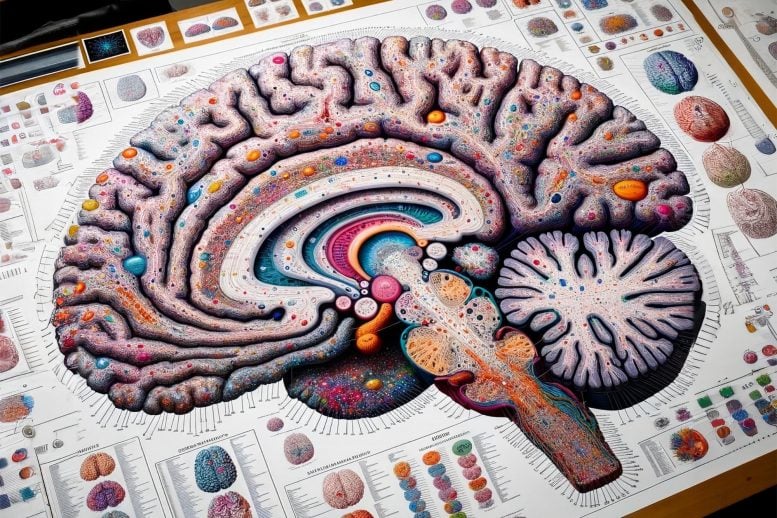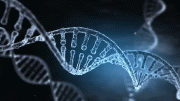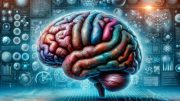
Researchers from the University of California San Diego, in a major collaborative effort, have mapped gene switches in different brain cell types by analyzing over a million human brain cells. This study, part of the BRAIN Initiative, highlighted the relationship between certain cell types and neuropsychiatric disorders. They further used AI to forecast the effects of specific high-risk gene variants.
Researchers map gene switches and brain cell types associated with schizophrenia, bipolar disorder, Alzheimer’s disease, and major depression.
In a large, multi-institutional effort led by University of California San Diego (UCSD), researchers have analyzed more than a million human brain cells to produce detailed maps of gene switches in brain cell types, and revealed the links between specific types of cells and various common neuropsychiatric disorders. The team also developed artificial intelligence tools to predict the influence of individual high-risk gene variants among these cells and how they may contribute to disease.
“The human brain isn’t homogenous. It’s more like a mosaic of different cell types that look different and serve different functions. Mapping out the different types of cells in the brain and understanding how they work will ultimately help us discover new therapies that can target individual cell types relevant to specific diseases.” — Bing Ren, PhD
BRAIN Initiative and Its Goal
This groundbreaking research, presented in a special issue of Science on October 13, 2023, is part of the National Institute of Health’s Brain Research Through Advancing Innovative Neurotechnologies Initiative, or The BRAIN Initiative, launched in 2014. The initiative aims to revolutionize understanding of the mammalian brain, in part, through the development of novel neurotechnologies for characterizing neural cell types.
Understanding Cellular Differences
Every cell in a human brain contains the same sequence of DNA, but different cell types use different genes and in different amounts. This variation produces many different types of brain cells and contributes to the complexity of neural circuits. Learning how these cell types differ on a molecular level is critical to understanding how the brain works and developing new ways to treat neuropsychiatric illnesses.
The Complexity of the Human Brain
“The human brain isn’t homogenous,” said senior author Bing Ren, PhD, professor at UC San Diego School of Medicine. “It’s made up of an enormously complex network of neurons and non-neuronal cells, with each serving different functions. Mapping out the different types of cells in the brain and understanding how they work together will ultimately help us discover new therapies that can target individual cell types relevant to specific diseases.”
Key Findings From the Study
In the new study, the researcher team analyzed more than 1.1 million brain cells across 42 distinct brain regions from three human brains. They identified 107 different subtypes of brain cells and were able to correlate aspects of their molecular biology to a wide range of neuropsychiatric illnesses, including schizophrenia, bipolar disorder, Alzheimer’s disease, and major depression. The researchers then use this data to create machine-learning models to predict how certain sequence variations in the DNA can influence gene regulation and contribute to disease.
Ongoing Research and Future Endeavors
While these new results offer significant insights into the human brain and its pathology, scientists are still far from done with mapping the brain. In 2022, UC San Diego joined the Salk Institute and others in launching a Center for Multiomic Human Brain Cell Atlas, which aims to study cells from over a dozen human brains and ask questions about how the brain changes during development, over people’s lifespans, and with disease.
“Scaling up our work to an even greater level of detail on a larger number of brains will bring us one step closer to understanding the biology of neuropsychiatric disorders and how it can be rehabilitated,” said Ren.
Reference: “A comparative atlas of single-cell chromatin accessibility in the human brain” by Yang Eric Li, Sebastian Preissl, Michael Miller, Nicholas D. Johnson, Zihan Wang, Henry Jiao, Chenxu Zhu, Zhaoning Wang, Yang Xie, Olivier Poirion, Colin Kern, Antonio Pinto-Duarte, Wei Tian, Kimberly Siletti, Nora Emerson, Julia Osteen, Jacinta Lucero, Lin Lin, Qian Yang, Quan Zhu, Nathan Zemke, Sarah Espinoza, Anna Marie Yanny, Julie Nyhus, Nick Dee, Tamara Casper, Nadiya Shapovalova, Daniel Hirschstein, Rebecca D. Hodge, Sten Linnarsson, Trygve Bakken, Boaz Levi, C. Dirk Keene, Jingbo Shang, Ed Lein, Allen Wang, M. Margarita Behrens, Joseph R. Ecker and Bing Ren, 13 October 2023, Science.
DOI: 10.1126/science.adf7044
Co-authors of the study include: Yang Eric Li, Sebastian Preissl, Michael Miller, Zihan Wang, Henry Jiao, Chenxu Zhu, Zhaoning Wang, Yang Xie, Olivier Poirion, Colin Kern, Lin Lin, Qian Yang, Quan Zhu, Nathan Zemke, Sarah Espinoza, Jingbo Shang and Allen Wang at UC San Diego, Nicholas D. Johnson Antonio Pinto-Duarte, Wei Tian Nora Emerson, Julia Osteen, Jacinta Lucero, M. Margarita Behrens and Joseph R. Ecker at the Salk Institute for Biological Studies, Kimberly Silett and Sten Linnarsson at Karolinksa Institute Anna Marie Yanny, Julie Nyhus, Nick Dee, Tamara Casper, Nadiya Shapovalova, Daniel Hirschstein, Rebecca D. Hodge Trygve Bakken, Boaz Levi and Ed Lein at Allen Institute of Brain Science and C. Dirk Keene at University of Washington Seattle.
The study was supported by the National Institutes of Health (grants UM1MH130994, U01MH114812, U54HG012510 and S10 OD026929), the National Science Foundation (grant OIA-2040727); the Nancy and Buster Alford Endowment, the Life Sciences Research Foundation, as well as gifts from Google, Adobe and Teradata.









What I have observed in terms of laptop or computer memory is there are specific features such as SDRAM, DDR and many others, that must match the technical specs of the motherboard. If the pc’s motherboard is very current while there are no os issues, replacing the storage space literally normally requires under an hour or so. It’s one of many easiest laptop or computer upgrade treatments one can consider. Thanks for giving your ideas.